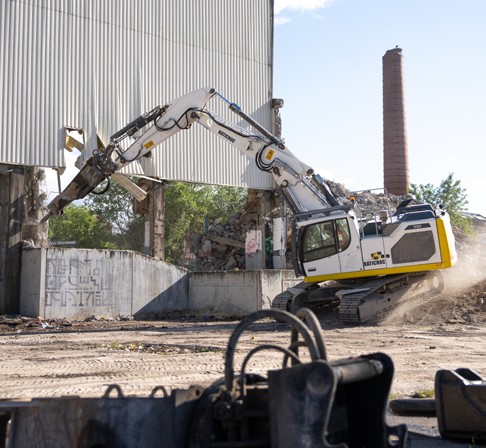LIEBHERR
Located on the outskirts of Mulhouse in Alsace, France, family owned firm, Batichoc have grown to become a driving force within the region offering a range of demolition, asbestos, earthworks and transportation services.
Formed from the former Gaidella company active from 1996 to 2008, the company has grown under the guidance of owner Patrick Gaidella and then his son Thomas, to become a well respected and integral part of the demolition industry throughout Alsace and beyond.
Over the years, the company have used a variety of excavators in their fleet to undertake their operations and have recently ordered a pair of new Liebherr machines to join an existing R 914 and R 926 as well as a fleet of wheeled loaders, L 508, L 544, L 566 and L 576. With the first machine, an R 930 G8 already delivered and hard at work, a second machine, this time a larger R 938 G8 just also arrived in the fleet
Manufactured just down the road from Batichoc’s head office, the Liebherr excavators have been added to allow the company to deal with the large workload they currently have on.
“WE HAVE HAD A LONG HISTORY OF SUCCESSFULLY USING LIEBHERR EXCAVATORS WITHIN OUR BUSINESS”
One of the larger projects they are involved in is the demolition and site clearance of a former paper mill in Turckheim. The site has been empty for over ten years but with prime development land becoming scarcer, Batichoc were called in to demolish the buildings and release the land ready for development.
With many of the smaller buildings already cleared from the site it was only the large production hall which remained standing. The building was constructed from a steel portal frame which was clad in concrete before a steel framed roof covered in plywood and felt had been installed. At over 16m in height, the ideal solution would have seen Batichoc bring in their 15m high reach machine. As this wasn’t available at the time the company decided that collapsing the structure and processing on the ground would be a viable alternative.
With the smaller Liebherr R 916 kept busy on clearing and processing fallen material, the bulk of the demolition work was left to the new R 930 G8 machine.
“THE LATEST GENERATION 8 MODELS ARE PROVING TO BE VERY ECONOMICAL AND RELIABLE MACHINES”
With an operating weight of 33 tonnes, the R 930 is powered by Liebherr’s fuel efficient four cylinder, 245hp D 934 diesel engine which offers excellent fuel economy figures averaging just 15.96 litres per hour. Constructed on a long undercarriage with 750mm track pads, the excavator has been fitted with Liebherr’s own rebar deflectors helping keep errant material away from the sides and underside of the upper structure.
The R 930’s upper structure has been finished in Batichoc’s white and yellow colour scheme to match the rest of their fleet. Unlike many manufacturers where special paint finishes are applied following the build process, Liebherr France paint every part prior to assembly to ensure a perfect, defect free finish.
A common site on demolition projects across mainland Europe is the fitment of a two-piece boom for demolition machines. Not only does this allow a greater reach than a standard mono boom, but it also allows for heavier attachments to be used close in at ground level. With this particular set up of 6.4m two-piece boom and 3.2m stick gives the excavator a potential pin height of just over 10m. Add on the additional OilQuick coupler and the length of a shear and this gives the Liebherr a potential working height of close on 12m. Batichoc have opted for the heavier 6.1 tonne counterweight to enable the excavator to handle a variety of attachments at this radius without creating an issue with the machine’s stability. A full suite of additional hydraulic services has been specified to allow sufficient oil flow and pressures to be met for each oil hungry attachment whilst a dedicated drain line ensures oil is transferred back into the tank to allow it to keep a lower temperature.

To protect the operator and cab, a sturdy ROPS and FOPS guarding has been fitted as have a set of boom and stick cylinder guards. Using a selection of attachments the operator was able to remove the metal sheeting to the sides of the structure prior to removing the lower structural bracing. Once this was complete, a quick change of to a hydraulic pulveriser and the concrete encasing each steel column was cracked leaving a skeleton of rebar.
Another tool change to a steel shear and the supporting legs were cut allowing a section of the building to be dragged safely inwards to the ground. Once this section had been felled it was an easy and safer task to strip the wooden sheets and roof coverings off before segregating them for recycling and disposal. This was the same for the steel frame which was cut into sections before being loaded away for recycling leaving the remainder of the concrete on the floor to be cleared and crushed.
‘We have had a long history of successfully using Liebherr excavators within our business.’ Patrick Gaidella commented. ‘The latest Generation 8 models are proving to be very economical and reliable machines, more than capable of talking our demolition and earthmoving projects.’